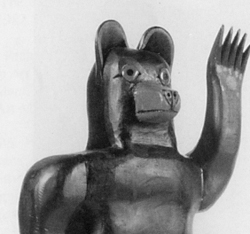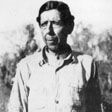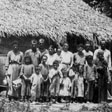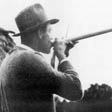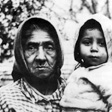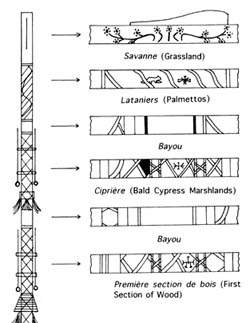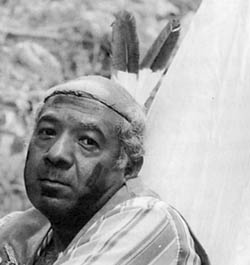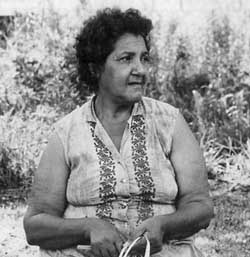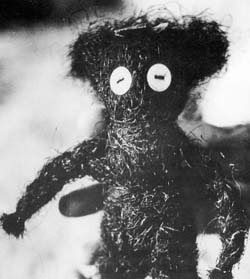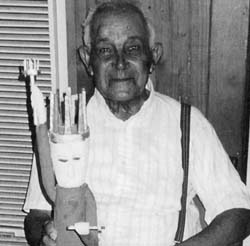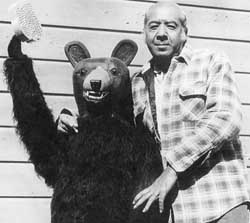Houma Indian Arts: Triptych
Ivy Billiot, Cyril Billiot, Marie Dean
Catalog for an exhibit curated by Frédéric Allamel from the collection of Warren and Sylvia Lowe
Preface from the Collector
By Warren Lowe
I first became aware of the work of Cyril Billiot in September 1983. Sylvia and I were living in Shreveport at the time, and I was traveling through Lafayette on my way to visit a self-taught carver in the Jeanerette area. Stopping at the Louisiana Native Crafts Festival, part of Festivals Acadiens, I saw a table cluttered with wonderful cypress carvings of unpainted crabs, crawfish, and alligators of varying sizes and shapes. While simple in design and devoid of detail, the carvings had a remarkable appeal. When I inquired about the carvings, someone pointed to a solitary figure sitting under the shade of a nearby tree who was identified as the maker. I introduced myself to this shy, modest man and told him that I had become an instant admirer of his work.
On subsequent trips to South Louisiana, visits to Cyril Billiot's home became part of the itinerary. It was on one of those early visits that Mr. Billiot took me into his son's bedroom where small boat carvings were displayed. This was my first exposure to the work of Ivy Billiot. It was not until one or two years later, however, that I met Ivy, who has become an accomplished carver in his own right.
Most of the early work of Cyril Billiot consisted of marine and swamp life—crustaceans, reptiles, and birds—and these carvings were usually unpainted. When a piece was painted in a single hue—an alligator, for example—Mr. Billiot would leave some smart part, such as the tip of a tail unpainted so the purchaser "would know that the piece was made from wood." In later years, he began to paint more of his pieces, often using inexpensive paints, even poster paints that he could purchase at local discount or hobby stores. And as more people became aware of his work, he expanded his repertoire and began to carve animals that were not indigenous to the southern swamps, as well as human figures such as Uncle Sam, Abraham Lincoln, Indian chiefs, and clergy.
The work of Ivy Billiot has shown a remarkable evolution. When he first began to carve, his early work resembled that of his father's, the carvings being almost indistinguishable as to maker, and usually consisted of the same subject matter, unpainted crabs and crawfish. From there, his work grew to include other species carved by his father, including birds and alligators. However, as Ivy continued to work, his skill as a carver also grew, and he began to add more detail and realism to his work. He also began to paint his work in more lifelike colors and shadings, mixing his own paints when necessary to achieve the desired hues. As his work became more highly sought by collectors, Ivy, like his father, began to carve more exotic forms of wildlife, including animals he had only seen in pictures or on television, such as apes, elephants, and giraffes. However, he is clearly most comfortable carving fauna native to the South Louisiana swamps, although, as he puts it "I can carve anything that walks, swims, or flies."
It is fitting that this father and son, along with another important Houma Indian artist, Marie Dean, be honored for their vision through this wonderful exhibition. Sylvia and I have been fortunate to have the Billiots as friends, and their carvings have lived in and warmed our house for many years. We hope that those who view this exhibit will experience some of the same pleasures this work has given us.
Visual Chronicles of the Houmas' Daily Life
By Frédéric Allamel
I would argue that art is first and foremost an art of living. This assertion seems to be a leitmotiv in most of my writings dealing with outsider art. However, after conducting an ethnographic investigation among the Houma Indians, I feel the urge to propose a new variant: art as a visual discourse about living—living more precisely in the swamplands of South Louisiana. French anthropologist Marcel Mauss coined the concept of "total social phenomenon" in one of his seminal essays (The Gift, 1923). From this perspective, social life is a system of interactive relations that requires a holistic approach. Contrastingly, modern man has broken into pieces this syntagmatic chain in an attempt to understand the complexity of the world. In other words, man's experience has been divided into separate systems of knowledge including economic and political systems, religion and aesthetics, etc. The interdisciplinary philosopher of the past may appear obsolete, but he used to provide a full picture of the human condition, unlike today when any comprehensive analysis of a society involves contributions by multiple social scientists. Therefore, I will adopt Mauss’s perspective throughout this study, as Houma arts epitomize the notion of holism and relate to all aspects of this Indian culture.
The art of the Houmas depicts a journey throughout the very nature of daily life, and consequently throughout the entire field of social studies. Its objects are not isolated productions that are solely made for art's sake; they are dynamic processes that are interwoven with all aspects of Houma culture. Just pull one of them and the whole tribal way of life is told in solid speech. In the early 1990s, I wrote an article related to Ivy Billiot's blowguns ("Anatomie d'une sarboucane" in Études créoles) that showed how, besides their initial utilitarian function, these hunting tools represent an abstract of the communal territory and, so to speak, an indigenous "ecology of the mind". The Great Plain Indians were well known for painting buffalo hides, leggings or moccasins on which they included crucial geographical motifs " (…) such as mountains, rivers, trails, camping sites, which are important to the Indians who inhabit the endless prairies" (Franz Boas, Primitive Art, 1955). In an environment that is characterized by its immensity, Native Americans needed referential marks. In the same vein, Ivy Billiot emerges as the cartographer of the unpredictable marshlands. Indeed, his blowguns constitute a true map of these marshy lands, containing topographical, botanical, and zoological data of the highest importance for the Houmas' livelihood (Fig. 1). In the maze of the bayous, combined with the dangers of wildlife and some native grasses such as les herbes à l’envers (literally the 'upside down grass' that supposedly alters spatial memory), his sarboucane takes on the value of a letter allowing safe-passage. In this context, art provides a mnemotechnic device containing the essential principles for living in a very peculiar and unique environment.
The present exhibition allows us to fully appreciate each individual Indian artwork for its intrinsic qualities. However, these objects are also a "meeting point" (Pierre Francastel, Études de sociologie de l'art) in the sense that they introduce the viewer to the whole universe of a Native American tribe. In other words, the artistic production at large represents the blueprints of Houma cultural structures.
Indeed, when Marie Dean makes a palmetto basket, she performs a technical act, but in a way she also weaves together layers of ethnic knowledge and savoir-faire. The same applies to Ivy and Cyril Billiot who engrave communal statements in their woodcarvings. However, one shouldn’t limit this study to semantics only, although there is an obvious visual syntax at work in these so-called primitive arts. As a matter of fact, this exhibition will attempt to comprehend this native aesthetics in its dynamic relationship with the whole of Houma culture. As the following synopsis will show, the Billiots' carvings as well as Marie Dean's basketry intermingle so intricately with traditional economy, vernacular technology, religious beliefs and ethnic identity that they generate a pictorial discourse on the Houmas' worldview, a draft of what real life is about in this marine environment.
A Trilogy of Change: Cross-Portraits
By Frédéric Allamel
From an artistic viewpoint, the association within the same exhibition of three distinct bodies of work displays at once the dynamic forces at play in an indigenous aesthetics. Indeed, on the one hand, Marie Dean illustrates to the utmost the intrinsic qualities of Houma ethnic crafts. On the other hand, Cyril Billiot departs somewhat from codified techniques and repertoire—while maintaining strong ties with his cultural and environmental backgrounds. Finally, Ivy Billiot goes one step further in his depiction of subject matter that is far remote from the Houmas' experience (exotic wildlife) or closely tied to a more recent pan-Indianism (i.e., his identification to the character of "Red Feather", an archetypal Indian given as his personal hero). The juxtaposition of these three artistic perspectives must not be seen as the illustration of an evolutionary process, along with its inherent value judgments opposing primitivism to refinement. To the contrary, the purpose of this triptych is to emphasize the importance of the transmission of knowledge and the ongoing creativity within the same native community. Indian art must be valued for its ageless cultural heritage as well as its contemporary trends, for its continuum linking the past to the future—already in process in today's aesthetics. In other words, this exhibition claims to be both a sanctuary for immemorial traditions and a laboratory toward new artistic endeavors.
Marie Dean: a master in traditional Houma crafts
Marie Dean was born in 1916 near Dulac, Terrebonne Parish, where she has spent her entire life in a small house along Bayou Grand Caillou. She was raised in a very artistic family, that is to say a typical household according to Houma standards: two of her brothers (Lawrence and Thomas Billiot) are famous craftsmen and her sister (Florestine) is also a basket maker. She was a young girl when she learned her crafts after the model of the elders; and in turn, she is now handing down this age-old tradition to her daughter and granddaughter. Like many people of her generation and ethnic background, she speaks French only.
Marie Dean is well known for her palmetto braiding, which is the most important craft form among the Houmas. Palmetto palms are very abundant in Southeast Louisiana marshlands and have been widely used as a building material in vernacular architecture as well as in basketry. Let us follow Marie Dean step by step as she skillfully creates one of her baskets. At first, she goes to the lataniers (the palmetto grounds) near her home for harvesting. There, she cuts the heart (le cœur) only, neglecting the open fans that are too stiff to weave. Back home, she puts the palm leaves on a clothesline or a window screen for several weeks. Once the palmetto is sundried enough, 'Miss' Marie slits each frond into a 1/4-inch strand and starts plaiting, using up to seven strips for a braid as long as sixty feet. At last, she coils the braid in such a way that the edges slightly overlap before sewing the rows together with a colored thread. The exact same technique is used in the making of fans, field hats, purses, etc.
Another indigenous plant is the Spanish moss that the Houma Indians used to harvest for various purposes: mattresses, bousillage (moss mixed with mud in the building of houses and chimneys), mooring ropes, horse blankets, etc. Today, several Indian women still use this material for creating different styles of dolls called catins—in standard French, the word refers to a woman of easy virtue. Marie Dean collects "la bonne mousse" (the good moss) from nearby bald cypresses, and then she washes it in the bayou to make it clean. Afterwards, she mounds it in her backyard and lets it dry up to six months. In this process, the grey coating disappears and gradually reveals the black cortex. At this stage, the Spanish moss is now ready to be fashioned into dolls of various sizes. While Marie Verret (Bayou Dularge) used to delicately dress her own catins with fabric, Marie Dean braids palmetto clothes and puts some in plaited cradles. Besides these anthropomorphic effigies, some catins are shaped after local animals such as turtles and alligators.
Due to arthritis in her hands, Marie Dean has now reduced her craft activities, although she keeps working daily, creating functional objects that are masterly produced at the crossroads of art and the everyday. One may argue that a broom shouldn’t be seen in an art exhibition. Actually, museum space is well deserved when it is a palmetto frond broom with a braided handle depicting a time-honored union of aesthetics and daily life. Thanks to Marie Dean and her peers, the apparently antinomic concept of household arts is finally justified.
Marie Dean's work has been widely exhibited in crafts and folklife festivals throughout the State. She has won state and national recognition: twice the Certificate of Appreciation by the Smithsonian Institution, Office of Folklife Programs (1985 & 1989); Louisiana World's Fair (New Orleans, 1984). One can see her work in the online Creole State Exhibit, at the National Museum of the American Indian in Washington, D.C. and at the Lafayette Natural History Museum and Planetarium. Jan Arnow's book, By Southern Hands, includes a section on her palmetto baskets (42-4) and Spanish moss dolls (58-60). See also Oradel Nolen Morris, I hear the Song of the Houmas (110), and Kniffen, Gregory and Stokes, The Historic Tribes of Louisiana (170).
One should also mention that Houma baskets and other crafts are to be found in various museum collections: the Denver Art Museum, Colorado; the Philbrook Art Center, Tulsa, Oklahoma; the Williamson Museum, Northwestern State University, Natchitoches, Louisiana; the Museum of the American Indian (Heye Foundation), New York; the Peabody Museum, Salem, Massachusetts.
Cyril Billiot: A Native American Folk Artist
Like Marie Dean (born Billiot), his distant cousin, Cyril Billiot was born in the French-speaking Houma Indian community of Dulac, along Bayou Grand Caillou. He later moved to Houma and made a living as a carpenter and a bricklayer. He is also a gifted craftsman (carvings, blowguns, musical instruments, etc.) and is especially well known for his cypress splint baskets. His siblings were equally artistic—woodcarvings, model boats, basket making, etc.
Cyril Billiot is above all a wood carver and his greatest contribution to Houma arts is undoubtedly his wonderful bestiary that depicts the rich diversity of South Louisiana wildlife as well as domestic animals. In a sense, he is a self-taught equivalent of John James Audubon—although his artwork could be qualified as crude, raw, or better, minimalist. He uses no chisel or delicate pastels, but instead a knife, a casse-tête (a kind of axe) and a lot of house paint. Quite often, he leaves materials unpainted and he always makes the most of what he has at hand. For instance, once I commissioned a snake, and expected a rather sinuous reptile. To my great surprise he showed me a piece that was made out of a broomstick and said: "This one goes straight!" That day, he saved me from conformist thinking. Besides his luxuriant fauna, he has also created compelling human figures. Cyril Billiot no longer carves and is now in his late eighties. He currently resides in a nursing home in Houma.
Cyril Billiot's work is mentioned in Oradel Nolen Morris's book, I Hear the Song of the Houmas (69, 110); Kniffen, Gregory and Stokes, The Historic Tribes of Louisiana (170); Jan Arnow, By Southern Hands (149). The Creole State Exhibit and the Lafayette Natural History Museum and Planetarium display some of his work: white cypress basket, carved wooden redfish, and crab and crawfish effigies. His work is also included in the permanent folk art collections of the Mississippi Museum of Art in Jackson, and the Art Museum of Southeast Texas in Beaumont.
Ivy Billiot: Toward Outsider Art
Ivy Billiot is Cyril’s son and he is also a native of Dulac (born in 1945). Ivy claims that he mostly learned about traditional Houma culture from his mother, Frida, who was very knowledgeable concerning wildlife, trawling, trapping, boat making, etc. One should not be surprised by such a reversal in gender roles given the matriarchal tendencies of the Houma Indians (Rosalie Courteau emerges as the most prominent leader in the tribe’s history). A confirmed bachelor, he lives now in Houma with his brother, Easton, who is a talented craftsman (baskets, model-boats, etc.). Ivy also makes traditional crafts such as basketwork and other Native American artifacts (blowguns, war clubs, bows and arrows with garfish scale points, calumets, medicine man’s staffs, etc.). He paints as well, although his paintings are greatly inspired by the style of the Southwest and the Great Plains Indians.
His artistic career started when he was a four-year-old boy creating his own wooden toys. Like most Houma children of his age playing along the bayou, he made little pirogues that soon turned into a complex flotilla. Of course, his father’s carvings influenced him at first. However, Ivy Billiot’s personal style evolved rapidly, and his unique production involves huge pieces or, to the contrary, miniatures. One can easily detect important stylistic differences in their respective bodies of works. Indeed, Ivy's carvings are far more refined and carefully painted, always depicted with a sharp sense of detail. For instance, one of his "crabmen" shows a Houma Indian paddling in his pirogue, complete with traps, crabs, a basket, and an ice-chest containing little knives and tiny cans of Coke—including the Corporation's logo.
From the early stage, his artwork has now developed tremendously, following a highly personal path. His most recent sculptures include a life-size bestiary, anthropomorphic figures, Noah's Arks, and his subject matter is always expanding. I would best describe Ivy as an inventor who uses art as a methodological tool for investigating world zoology as well as Native American cultures. There is a theoretical tendency to consider that ethnic arts are assigned to a relative stability, as if they had been created once for all in ancient times, and should never depart from these ancestral models. In this regard, Ivy Billiot's recent trend toward outsider art offers a stimulating mutation and the reassurance that there will always be Houma Indian arts, wherever their culture evolves.
Ivy Billiot's work is shown in several art galleries in Louisiana (Cajun Village in Sorrento, Lafayette, Baton Rouge, New Orleans, etc.), Texas (Yard Dog in Austin, the Mesnil Collection Bookstore in Houston), North Carolina (Blue Spiral Gallery in Ashville). It is also exhibited at the Creole State Exhibit, the Lafayette Natural History Museum and Planetarium (carvings, blowgun), the Mississippi Museum of Art (Jackson) and the Art Museum of Southeast Texas (Beaumont). He was commissioned to provide artifacts for the "Native Peoples of Louisiana" exhibit at the Southdown Plantation Terrebonne Museum in Houma. Ivy Billiot appears regularly at the Jazz and Heritage Festival in New Orleans as well as other Folklife Festivals throughout the Southeastern United States. Chuck and Jan Rosenak have included him in their Collector's guide. See also my article “Anatomie d'une sarboucane".
References
Allamel Frédéric. "Anatomie d'une sarboucane." Études Créoles vol. XIV. nº2 (1991): 128-46.
Arnow, Jan. By Southern Hands: A Celebration of Craft Traditions in the South. Birmingham: Oxmoor House, 1987.
Kniffen, Fred B., Gregory, Hiram F., Stokes. George A. The Historic Tribes of Louisiana. Baton Rouge: Louisiana State University Press, 1987.
Morris, Oradel Nolen. I Hear the Song of the Houmas / J’entends la chanson des Houmas. Houma: Paupieres Publishing Company, 1992.


